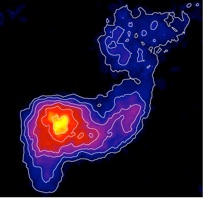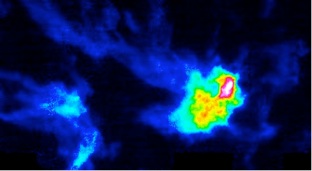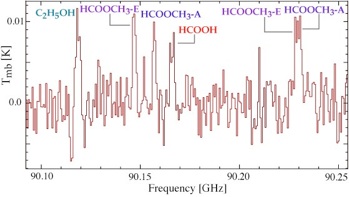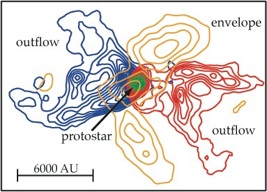Héctor G. Arce

Research
I study the formation of stars and the physical and chemical processes in the interstellar medium. My research focuses on observations of the gas and dust in star-forming regions. I mostly use radio, millimeter and sub-millimeter telescopes to conduct my research, as well as data from infrared and optical telescopes. I am particularly interested in outflows from young stars, their role in the star formation process, and how they affect the physical and chemical properties of the surrounding environment. I also study the evolution cores, how they collapse and form stars, and eventually dissipate. Other research topics include molecular cloud structure, interstellar dust, and protoplanetary disks.
Core Evolution
Stars form as a consequence of the gravitational contraction of the dense gas in molecular cloud cores. The inward and outward motions of the circumstellar material have an impact on the final mass of the star. Studying infall and outflow in cores is essential to fully understand star formation from beginning to end. A better understanding of the star formation process and the origin of stellar masses can only be achieved by studying the physical properties of cores and their surroundings at different evolutionary stages.



Outflow Chemistry
Shocks produced by the interaction of high-velocity protostellar winds and the ambient cloud can heat the surrounding gas and dust, thereby triggering chemical processes that would otherwise not take place in the quiescent medium. In many cases these chemical processes result in abundance enhancement of different molecules, including complex molecules that may be important for life.
Molecular Clouds and Star Forming Regions
Stars form in molecular clouds. Studying the density and velocity structure of these clouds is part of understanding how stars form, the physical processes that affect their formation efficiency, their evolution and mass distribution. Click here for more information on the COMPLETE project of Star Formation.
Molecular Outflows and their Impact on Clouds
Protostellar outflows may extend to distances of more than 1pc from their source, thereby injecting energy and momentum to their parent cloud. They can feed the cloud turbulence as well as help in the dispersal of gas from the cloud. We are carrying a survey of clouds harboring clusters at different evolutionary stages in order to study the impact of outflows on the gas dynamics, the evolution and the star formation rate of the cloud. We will use the results from this study to compare with numerical simulations of outflow-driven turbulence.

Outflow-Envelope Interaction
The envelope around a low-mass protostar is the main mass reservoir of the forming star. Outflows powered by the protostar and launched close to the surface of the young stars can perturb the surrounding envelope and may affect the mass-assembling process. Millimeter interferometers are essential for conducting these studies, as they can probe the dynamics of the gas close to the protostar. Using existing (e.g., CARMA, PdBI and SMA) and future interferometers (ALMA) will allow us to understand how outflows impact the envelope, the mass-assembling process and the final mass of the forming star





